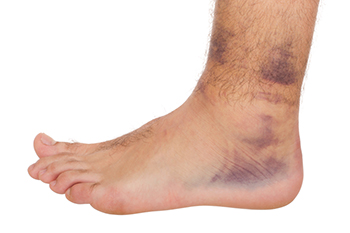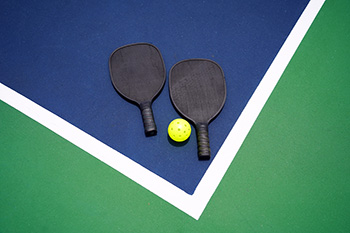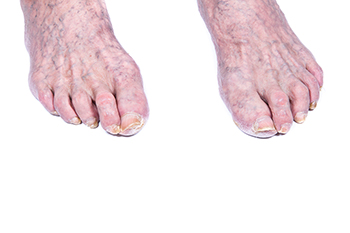Middlefield (860) 349-8500
Wallingford (203) 294-4977
Middlefield (860) 349-8500
Wallingford (203) 294-4977

The bones in the ankle are connected by a variety of ligaments. Ankle sprains occur when these ligaments either become overstretched or torn, usually because the ankle is twisted. Mild ankle sprains usually just mean that the ankle is tender and swollen, but more severe ankle sprains can make the ankle unstable and unable to support any weight. A podiatrist can examine your ankle and determine whether it is sprained. Because the symptoms of an ankle sprain are often like that of a broken ankle, an X-ray or other imaging test may be necessary. Upon the diagnosis of an ankle sprain, or fracture, a podiatrist will be able to provide a treatment plan for the injury. Recurring or severe sprains can cause long-term weakness and joint pain if not properly treated. If you suspect you may have sprained an ankle, it is suggested that you make an appointment with a podiatrist.
Although ankle sprains are common, they aren’t always minor injuries. If you need your ankle injury looked at, contact Dr. Gordon Fosdick from Affiliated Foot Care Center. Our doctor can provide the care you need to keep you pain-free and on your feet.
How Does an Ankle Sprain Occur?
Ankle sprains are the result of a tear in the ligaments within the ankle. These injuries may happen when you make a rapid shifting movement while your foot is planted. A less common way to sprain your ankle is when your ankle rolls inward while your foot turns outward.
What Are the Symptoms?
Preventing a Sprain
Treatment of a Sprain
In many cases, the RICE method (Rest, Ice, Compression, and Elevate) is used to treat ankle sprains. However, you should see a podiatrist to see which treatment option would work best with your injury. In severe cases, surgery may be required.
It is important to ask your doctor about rehab options after you receive treatment for your injury. Stretching, strength training, and balance exercises may help the ankle heal while also preventing further injury.
If you have any questions, please feel free to contact our offices located in Middlefield and Wallingford, CT . We offer the newest diagnostic and treatment technologies for all your foot care needs.

Peripheral neuropathy, which arises from damaged or diseased peripheral nerves, significantly impacts the feet by disrupting the transmission of signals from the brain. Symptoms of peripheral neuropathy can include numbness, tingling, sharp pain, and muscle weakness in the feet. Such symptoms can make everyday activities challenging, and may cause balance issues or foot injuries that are unnoticed due to loss of sensation. The underlying causes of peripheral neuropathy are diverse, with diabetes being a prevalent factor. An early diagnosis and treatment of peripheral neuropathy is vital to manage symptoms and prevent further nerve damage. A podiatrist can perform a thorough exam and order diagnostic tests to develop a comprehensive treatment plan for you. This may include medication or lifestyle modifications to alleviate discomfort and improve mobility. If you have peripheral neuropathy that affects your feet, it is suggested that you schedule an appointment with a podiatrist for an exam and treatment.
Neuropathy
Neuropathy can be a potentially serious condition, especially if it is left undiagnosed. If you have any concerns that you may be experiencing nerve loss in your feet, consult with Dr. Gordon Fosdick from Affiliated Foot Care Center. Our doctor will assess your condition and provide you with quality foot and ankle treatment for neuropathy.
What Is Neuropathy?
Neuropathy is a condition that leads to damage to the nerves in the body. Peripheral neuropathy, or neuropathy that affects your peripheral nervous system, usually occurs in the feet. Neuropathy can be triggered by a number of different causes. Such causes include diabetes, infections, cancers, disorders, and toxic substances.
Symptoms of Neuropathy Include:
Those with diabetes are at serious risk due to being unable to feel an ulcer on their feet. Diabetics usually also suffer from poor blood circulation. This can lead to the wound not healing, infections occurring, and the limb may have to be amputated.
Treatment
To treat neuropathy in the foot, podiatrists will first diagnose the cause of the neuropathy. Figuring out the underlying cause of the neuropathy will allow the podiatrist to prescribe the best treatment, whether it be caused by diabetes, toxic substance exposure, infection, etc. If the nerve has not died, then it’s possible that sensation may be able to return to the foot.
Pain medication may be issued for pain. Electrical nerve stimulation can be used to stimulate nerves. If the neuropathy is caused from pressure on the nerves, then surgery may be necessary.
If you have any questions, please feel free to contact our offices located in Middlefield and Wallingford, CT . We offer the newest diagnostic and treatment technologies for all your foot care needs.

Ankle pain while cycling can stem from various factors related to bike fit, technique, or underlying conditions. Improper bike setup, such as incorrect saddle height or pedal position, can strain the ankles during pedaling. Poor cycling techniques, like excessive ankle flexion or inadequate warm-up, may also contribute to discomfort. Common parts of the ankle affected by cycling include the Achilles tendon, which can become inflamed due to repetitive motion, and the ankle joint itself, which is susceptible to overuse injuries like sprains or strains. Additionally, conditions such as tendonitis or arthritis can exacerbate pain. Ensuring proper bike fit, warming up before rides, and maintaining good ankle flexibility and strength through targeted exercises can help prevent ankle pain. If you enjoy cycling and have endured an ankle injury, it is suggested that you consult a podiatrist who can offer treatment solutions, in addition to providing ankle injury prevention tips.
Ankle pain can be caused by a number of problems and may be potentially serious. If you have ankle pain, consult with Dr. Gordon Fosdick from Affiliated Foot Care Center. Our doctor will assess your condition and provide you with quality foot and ankle treatment.
Ankle pain is any condition that causes pain in the ankle. Due to the fact that the ankle consists of tendons, muscles, bones, and ligaments, ankle pain can come from a number of different conditions.
Causes
The most common causes of ankle pain include:
Symptoms
Symptoms of ankle injury vary based upon the condition. Pain may include general pain and discomfort, swelling, aching, redness, bruising, burning or stabbing sensations, and/or loss of sensation.
Diagnosis
Due to the wide variety of potential causes of ankle pain, podiatrists will utilize a number of different methods to properly diagnose ankle pain. This can include asking for personal and family medical histories and of any recent injuries. Further diagnosis may include sensation tests, a physical examination, and potentially x-rays or other imaging tests.
Treatment
Just as the range of causes varies widely, so do treatments. Some more common treatments are rest, ice packs, keeping pressure off the foot, orthotics and braces, medication for inflammation and pain, and surgery.
If you have any questions, please feel free to contact our offices located in Middlefield and Wallingford, CT . We offer the newest diagnostic and treatment technologies for all your foot care needs.

Surprisingly, about 70 percent of people wear shoes that don’t fit well, leading to discomfort and potential long-term issues affecting the feet and ankles, as well as other body parts. To ensure a proper fit, start by measuring your feet, as sizes can vary between brands and your feet change over time. Shop in the afternoon when your feet are slightly swollen, ensuring a fit that accommodates daily activity. Look for shoes with adequate support and structure, avoiding overly soft footwear that lacks stability. Check for a thumb’s width of space at the toe and consider the shape of the shoe to avoid cramped toes. Heels higher than 1.5 inches can worsen foot problems. For those on carpets or with mobility issues, lightweight polyurethane soles are a better option than heavy rubber. Breathable materials and appropriate socks are also important to prevent moisture buildup and subsequent issues, like corns or blisters. Special features can accommodate specific conditions like diabetes, bunions, or hammertoe. For personalized advice and to address any foot-related concerns, it is suggested that you make an appointment with a podiatrist.
It is important to find shoes that fit you properly in order to avoid a variety of different foot problems. For more information about treatment, contact Dr. Gordon Fosdick from Affiliated Foot Care Center. Our doctor will treat your foot and ankle needs.
Proper Shoe Fitting
Shoes have many different functions. They cushion our body weight, protect our feet, and allow us to safely play sports. You should always make sure that the shoes you wear fit you properly in order to avoid injuries and deformities such as: bunions, corns, calluses, hammertoes, plantar fasciitis, stress fractures, and more. It is important to note that although a certain pair of shoes might be a great fit for someone else, that doesn’t mean they will be a great fit for you. This is why you should always try on shoes before buying them to make sure they are worth the investment. Typically, shoes need to be replaced ever six months to one year of regular use.
Tips for Proper Shoe Fitting
The shoes you buy should always feel as good as they look. Shoes that fit properly will last longer, feel better, and improve your way of life each day.
If you have any questions, please feel free to contact our offices located in Middlefield and Wallingford, CT . We offer the newest diagnostic and treatment technologies for all your foot care needs.
 Tarsal tunnel syndrome is a condition characterized by the compression of the tibial nerve as it travels through the tarsal tunnel, a narrow space on the inside of the ankle. This tunnel houses several vital structures, including the tibialis posterior tendon, the flexor digitorum longus tendon, and the posterior tibial artery and vein. When the tibial nerve is compressed, it can lead to pain, tingling, and numbness in the foot. The tibialis posterior tendon helps support the arch of the foot, while the flexor digitorum longus tendon aids in flexing the toes. The posterior tibial artery and vein are essential for blood circulation to the foot. If you have pain in this part of your foot, it is suggested that you consult a podiatrist who can diagnose and treat tarsal tunnel syndrome.
Tarsal tunnel syndrome is a condition characterized by the compression of the tibial nerve as it travels through the tarsal tunnel, a narrow space on the inside of the ankle. This tunnel houses several vital structures, including the tibialis posterior tendon, the flexor digitorum longus tendon, and the posterior tibial artery and vein. When the tibial nerve is compressed, it can lead to pain, tingling, and numbness in the foot. The tibialis posterior tendon helps support the arch of the foot, while the flexor digitorum longus tendon aids in flexing the toes. The posterior tibial artery and vein are essential for blood circulation to the foot. If you have pain in this part of your foot, it is suggested that you consult a podiatrist who can diagnose and treat tarsal tunnel syndrome.
Tarsal tunnel syndrome can be very uncomfortable to live with. If you are experiencing tarsal tunnel syndrome, contact Dr. Gordon Fosdick of Affiliated Foot Care Center. Our doctor can provide the care you need to keep you pain-free and on your feet.
Tarsal Tunnel Syndrome
Tarsal tunnel syndrome, which can also be called tibial nerve dysfunction, is an uncommon condition of misfiring peripheral nerves in the foot. The tibial nerve is the peripheral nerve in the leg responsible for sensation and movement of the foot and calf muscles. In tarsal tunnel syndrome, the tibial nerve is damaged, causing problems with movement and feeling in the foot of the affected leg.
Common Cause of Tarsal Tunnel Syndrome
The Effects of Tarsal Tunnel Syndrome
A physical exam of the leg can help identify the presence of tarsal tunnel syndrome. Medical tests, such as a nerve biopsy, are also used to diagnose the condition. Patients may receive physical therapy and prescriptive medication. In extreme cases, some may require surgery.
If you have any questions please feel free to contact our offices located in Middlefield and Wallingford, CT . We offer the newest diagnostic and treatment technologies for all your foot and ankle needs.

Pickleball, a fast-paced sport combining elements of tennis, badminton, and table tennis, often leads to foot injuries among players. The most common injuries include plantar fasciitis, characterized by pain in the heel or arch due to inflammation of the plantar fascia. Achilles tendonitis is another frequent issue, involving pain and stiffness in the tendon that connects the calf muscles to the heel. Ankle sprains are prevalent as well, occurring when the foot twists unnaturally during quick lateral movements. Stress fractures can also develop from repetitive impact on the feet. Preventing these injuries involves wearing proper footwear with good arch support, warming up before playing, and incorporating strength and flexibility exercises into a regular fitness routine. If you have injured your foot while playing pickleball, it is suggested that you confer with a podiatrist who can offer appropriate treatment solutions, and educate you on effective prevention techniques.
Ankle and foot injuries are common among athletes and in many sports. They can be caused by several problems and may be potentially serious. If you are feeling pain or think you were injured in a sporting event or when exercising, consult with Dr. Gordon Fosdick from Affiliated Foot Care Center. Our doctor will assess your condition and provide you with quality foot and ankle treatment.
Common Injuries
The most common injuries that occur in sporting activities include:
Symptoms
Symptoms vary depending upon the injury and in some cases, there may be no symptoms at all. However, in most cases, some form of symptom is experienced. Pain, aching, burning, bruising, tenderness, tightness or stiffness, sensation loss, difficulty moving, and swelling are the most common symptoms.
Treatment
Just as symptoms vary depending upon the injury, so do treatment options. A common treatment method is known as the RICE method. This method involves rest, applying ice, compression and elevating the afflicted foot or ankle. If the injury appears to be more serious, surgery might be required, such as arthroscopic or reconstructive surgery. Lastly, rehabilitation or therapy might be needed to gain full functionality in the afflicted area. Any discomfort experienced by an athlete must be evaluated by a licensed, reputable medical professional.
If you have any questions, please feel free to contact our offices located in Middlefield and Wallingford, CT . We offer the newest diagnostic and treatment technologies for all your foot care needs.

Gout is a type of arthritis caused by high levels of uric acid in the blood, leading to the formation of sharp crystals in the joints. The big toe is often affected, and the pain may become debilitating, some patients have difficulty in walking and completing daily activities. This condition can be triggered by factors such as genetics, obesity, and certain medical conditions. Diet plays a significant role in managing gout. Foods high in purines, such as red meat, organ meats, and certain seafood like sardines and shellfish, should be avoided as they can increase uric acid levels. Additionally, sugary beverages and alcohol, particularly beer, can exacerbate gout symptoms. On the other hand, a diet rich in low-purine foods can help manage gout effectively. These include fruits, vegetables, whole grains, and low-fat dairy products. Drinking plenty of water and maintaining a healthy weight can also help reduce uric acid levels. Individuals who have gout often experience extreme pain and discomfort, especially in their big toe. If this applies to you, it is strongly suggested that you are under the care of a podiatrist who can treat this condition, and lead you to making correct food choices.
Gout is a foot condition that requires certain treatment and care. If you are seeking treatment, contact Dr. Gordon Fosdick from Affiliated Foot Care Center. Our doctor will treat your foot and ankle needs.
What Is Gout?
Gout is a type of arthritis caused by a buildup of uric acid in the bloodstream. It often develops in the foot, especially the big toe area, although it can manifest in other parts of the body as well. Gout can make walking and standing very painful and is especially common in diabetics and the obese.
People typically get gout because of a poor diet. Genetic predisposition is also a factor. The children of parents who have had gout frequently have a chance of developing it themselves.
Gout can easily be identified by redness and inflammation of the big toe and the surrounding areas of the foot. Other symptoms include extreme fatigue, joint pain, and running high fevers. Sometimes corticosteroid drugs can be prescribed to treat gout, but the best way to combat this disease is to get more exercise and eat a better diet.
If you have any questions please feel free to contact our offices located in Middlefield and Wallingford, CT . We offer the newest diagnostic and treatment technologies for all your foot and ankle needs.

Maintaining good foot health is essential for seniors to ensure mobility and overall well-being. Regular foot care includes keeping feet clean and dry, which helps prevent infections. Moisturizing daily can prevent dry, cracked skin, while avoiding areas between the toes to reduce fungal growth. Wearing well-fitted, supportive shoes can prevent discomfort and reduce the risk of falls. It is also important to inspect feet regularly for any changes such as sores, redness, or swelling, and to address issues promptly. Trimming toenails straight across helps prevent ingrown nails, while gentle foot exercises can improve circulation and flexibility. Consulting a podiatrist for any persistent foot problems ensures appropriate treatment and care. If you have foot pain or are caring for an elderly person, it is suggested that you confer with this type of doctor who can effectively offer relief options, in addition to individualized foot care tips.
Proper foot care is something many older adults forget to consider. If you have any concerns about your feet and ankles, contact Dr. Gordon Fosdick from Affiliated Foot Care Center. Our doctor can provide the care you need to keep you pain-free and on your feet.
The Elderly and Their Feet
As we age we start to notice many changes in our body, but the elder population may not notice them right away. Medical conditions may prevent the elderly to take notice of their foot health right away. Poor vision is a lead contributor to not taking action for the elderly.
Common Conditions
Susceptible Infections
Diabetes and poor circulation can cause general loss of sensitivity over the years, turning a simple cut into a serious issue.
If you have any questions please feel free to contact our offices located in Middlefield and Wallingford, CT . We offer the newest diagnostic and treatment technologies for all your foot and ankle needs.
 Preventing blisters is important for maintaining healthy feet. One way to avoid the development of blisters is by wearing well-fitted shoes that don't rub or cause friction against your skin. Additionally, it is suggested to change socks throughout the day, as wet or sweaty feet are more likely to blister. If you are aware of a spot that may become sore when engaging in daily activities that can cause friction, such as walking, or running, consider padding the inflamed area to reduce pressure. Applying cushioning pads where blisters commonly form can provide extra protection and reduce friction. Keeping up with foot hygiene can also decrease the risk of developing a blister on the foot. Keep your toenails trimmed and smooth to prevent them from catching on your socks or shoes, which can cause rubbing and blisters. If you notice any redness or hot spots on your feet, take immediate action to prevent blisters from forming. If you have a blister, especially if it is large, painful, or showing signs of infection, it is suggested to visit a podiatrist for safe treatment.
Preventing blisters is important for maintaining healthy feet. One way to avoid the development of blisters is by wearing well-fitted shoes that don't rub or cause friction against your skin. Additionally, it is suggested to change socks throughout the day, as wet or sweaty feet are more likely to blister. If you are aware of a spot that may become sore when engaging in daily activities that can cause friction, such as walking, or running, consider padding the inflamed area to reduce pressure. Applying cushioning pads where blisters commonly form can provide extra protection and reduce friction. Keeping up with foot hygiene can also decrease the risk of developing a blister on the foot. Keep your toenails trimmed and smooth to prevent them from catching on your socks or shoes, which can cause rubbing and blisters. If you notice any redness or hot spots on your feet, take immediate action to prevent blisters from forming. If you have a blister, especially if it is large, painful, or showing signs of infection, it is suggested to visit a podiatrist for safe treatment.
Blisters are prone to making everyday activities extremely uncomfortable. If your feet are hurting, contact Dr. Gordon Fosdick of Affiliated Foot Care Center. Our doctor can provide the care you need to keep you pain-free and on your feet.
Foot Blisters
Foot blisters develop as a result of constantly wearing tight or ill-fitting footwear. This happens due to the constant rubbing from the shoe, which can often lead to pain.
What Are Foot Blisters?
A foot blister is a small fluid-filled pocket that forms on the upper-most layer of the skin. Blisters are filled with clear fluid and can lead to blood drainage or pus if the area becomes infected.
How Do Blisters Form?
Blisters on the feet are often the result of constant friction of skin and material, usually by shoe rubbing. Walking in sandals, boots, or shoes that don’t fit properly for long periods of time can result in a blister. Having consistent foot moisture and humidity can easily lead to blister formation.
Prevention & Treatment
It is important to properly care for the affected area in order to prevent infection and ease the pain. Do not lance the blister and use a Band-Aid to provide pain relief. Also, be sure to keep your feet dry and wear proper fitting shoes. If you see blood or pus in a blister, seek assistance from a podiatrist.
If you have any questions, please feel free to contact our offices located in Middlefield and Wallingford, CT . We offer the newest diagnostic and treatment technologies for all your foot care needs.